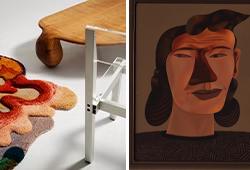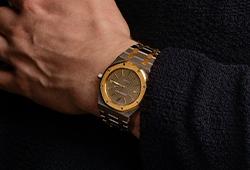Lynn Chadwick
"Pair of Cloaked figures"
A pair, monog. stamped C and dated -76. Marked 742 and numbered 4/8. Bronze 26 and 24.5 cm.
Exhibitions
Marlborough Fine Art, London, February - March 1978, and subsequently at Marlborough Fine Art Zurich, April -May 1978. Illustrated in the catalogue.
Literature
Farr & Chadwick, 1990, in the catalogue as no 742, p 284.
More information
Det var genom Venedigbiennalerna 1952 och 1956 som den engelske skulptören Lynn Chadwick fick sitt internationella genombrott och har sedan dess betraktats som ett av de viktigaste konstnärskapen inom den engelska efterkrigskonsten. De aktuella skulpturerna ”Pair of Cloaked figures” är från konstnärens 70-talsproduktion vilken känns igen genom dess ikoniska och mogna uttryck där formerna har renodlats och skalats ned.
Som betraktare möter vi två arketypiska och tidlösa former där det är svårt att säga om Chadwick hämtat sin inspiration från den neolitiska civilisationen eller om Jungs lära om arktypen och det kollektiva undermedvetna. Figurerna som befolkar konstnärens idévärld är hybrider som lånar drag av människor, fåglar, reptiler och insekter vilket gör att vi delvis identifierar oss med dem men samtidigt räds dem. I denna grupp är det egentligen bara figurernas ansikten som säger något om dem: kvadraten symboliserar mannen och triangeln kvinna (vilket är återkommande i hela hans produktion). Chadwick beskrev själv konsten som en mörk inre kraft vilken manifesterade sig för konstnären och översattes genom dennes förmåga och skicklighet. Det som vi betraktare fått översatt av konstnären är vi även fria att tolka. I ”Pair of Cloaked Figures” rör sig om ett tyst, statiskt men dynamiskt samspel där dessa mörka tunga symboler verkar på ett avskräckande men inbjudande sätt.
Artist
One immediately recognises Lynn Chadwick’s distinctive figures. They have their own visual language, with their formal language resembling no other. These majestic beings appear enigmatic, hardly at rest – rather vigilant. With figures which draw upon simplified geometric forms with sharply draped cloaks, these sculptures evoke associations and fascination.
Chadwick joined a new generation of artists which all debuted on the British art scene shortly after the World War. Europe was in ruin, and the world was arrested in great shock after having experienced the trials and tribulations of war. Chadwick himself was an active participant, having worked as a pilot in R.A.F. Already in his younger years Chadwick was sure that he wanted to direct his career into the world of art, yet his parents disapproved, and thus he was forced to compromise and thus began to study architecture. This is why Chadwick found himself working at an architectural firm before the onset of the war. It can therefore be argued that it is thanks to his architectural training that his sculptures exhibit such a strong geometrical aura. The aftermath of the war left Chadwich longing to create and to achieve something new. Yet it took a while for him to find the courage to fully commit, and thus he continued to have a successful career as a interior designer. In the 1940s Chadwich made a living by designing exhibition stands, furniture, wallpaper simultaneously as he began his career as an artist.
It was thanks to the Venice Biennale of 1952 and 1956 that Chadwick gained international recognition and has since then been thought to be one of the most important artists within the British post-war era. The expression in Lynn Chadwick's sculptures is deeply linked to his methods. For the most part Chadwick is solely self-taught, with his technique having been described as a three-dimensional metal drawing. Chadwick would bend and shape of rods into desired forms, then weld them together, after which he filled in the areas that were to be solid. For various sculptures he utilised metal plates, giving the impression of a “metal skin”. In the 1950s Chadwick began experimenting with bronze. Chadwick placed great emphasis on the patination of his sculptures, meticulously working on surface texture and color nuances.
The triangle is the overarching form in Chadwick’s art, which is sometimes combined with the rectangle. This form, often placed vertically or diagonally (never horizontally), forms the backbone of the sculpture and establishes the formal tension. The artist himself has declared that the triangle is the most stripped-down, basic form of the human body, and it is from this shape people are constructed. He had always clearly expressed how his primary inspiration lay always with the human form.
In contrast to many of his contemporaries who were inspired by ethnographic or classical art, Chadwick found inspiration from modern architecture. The artist never explained the symbolism or meaning behind his sculptures, rather he has left his blank to allow the viewer to form their own interpretations as to the reasonings behind these powerful, enigmatic figures.














































